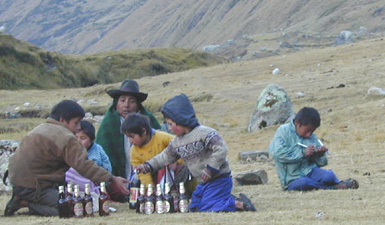
Her name is Katia. She teaches at the "Learning Place of the Heart," a one room school, high in an Andean valley on the sparsely populated edge of the national park that surrounds Machu Picchu. Her own children and husband live in the Peruvian city of Cusco; visiting her family requires a 4 to 6 hour walk out of the mountains, then long hours on a bus. Mostly she lives alone in a hut by the school. As a job necessity, she speaks both Quechua and Spanish. The schoolroom is full of pictures, mobiles, balloons -- she almost certainly provides them herself (with occasional help from tour groups like ours.) Some inner city schools in the US would be happy to have as many materials.
Her students are the children of the herding families in the park. I don't really know for certain, but I suspect they are pretty well off, by the standards of Andean alpaca and cattle herders who also grow a few potatoes. They have good-sized herds and large, close to pristine, areas on which to graze them. But their life style is not likely to persist into the next generation -- the park may decide they and their animals interfere with its overriding objective of capturing the tourist dollar. Already adult farmers must work off the land during fallow seasons to earn currency; grandparents and children remain behind in the remote valleys.
When the students grow up (at 13 or 14?) will they drift, out of necessity, to the margins of the cities, serving others as laborers and laundresses -- or will they have a chance to grab a piece of Peru's modern economy? The devotion of the Katias of the world will play a large role in their fate.

Student

Learning Place of the Heart

When the tourists come, residents set up the corner store.

Herding families' homes
This would be worthy of its own "Morning Retch" but I'll just dump it here: according to the today's NYT, "a new analysis of federal money that public schools receive for low-income students shows that a record number of the nation's school districts will receive less in the coming academic year than they did for the one just ended.
ReplyDelete"For the 2005-2006 school year, spending under the Department of Education's Title I program, which helps low-achieving children in high-poverty areas, is increasing by 3.2 percent, to $12.6 billion.
"But because of population shifts, growing numbers of poor children, newer census data and complex formulas that determine how the money is divided, more than two-thirds of the districts, or 8,843, will not receive as much financing as before."
What are these kids supposed to do without an education? Die?
What can I say, this story broke my heart.
ReplyDeleteIt's painful to see reality of my Peruvian Indigenous peoples.
When I talk about this issue with my countrymen, they accuse me of being a rebelious terrorist or something alike.
I really hope younger Peruvians will see the light one day, so we don't allow this unfairness to continue.